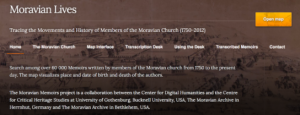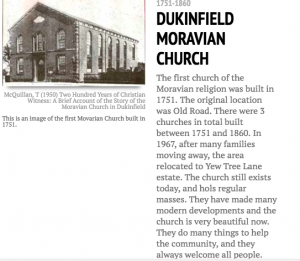For my final blog of the semester and class, I will be discussing the process of our final project. Our final project is a website on WordPress and it explains our complete process of transcribing the memoir of Elizabeth Grundy. We explained all of the tools we used to complete it, and how it answered our research question, “Were there different relationships between allegiance to family and allegiance to the church in Moravian lives?”. My group, Mitch, Meg, Caleb, and I worked extremely hard in order to answer this question, and I think we did a good job at it, with the help of all of the tools listed below.
The tools we used throughout our project were Moravian Lives, Oxygen, TEI File, WordPress, Voyant, Google Fusion, and Story Map.
Moravian Lives was the first site we worked with, as this was our transcription desk. This is where the original memoir was and we had to translate it word for word. It was very difficult at first because it was written in cursive, very unclear. We had to look very closely at it and ask our group members for advice on specific words. Eventually, we got the hang of it noticing that the different parts of our memoirs had similar abbreviations that were hard to encrypt.

The next tool we used was Oxygen. This was the way we tagged the different words and phrases in the memoir. We tagged place names, role names, person names, objects, events, health, and emotion. During this process, we had to search through the whole memoir finding words that matched these tags. We tagged as many as we could to make the process in the future easier to do, comparing tags.
TEI Files were the next thing we used during our process. This included the tagged memoir we made in oxygen, and then each group member was given a file to put their tagged memoir in.
WordPress was the tool we used to put our final website in. It was a useful tool to show our work in a great way. It was a bit confusing learning how to first use it, we struggled to add and delete menus and post certain things, but it ended up working out well. Voyant was the next tool we used and that had very many aspects to it. It’s different components allowed us to learn a lot more about Elizabeth Grundy and her life.
SteamGraph was one of the aspects of Voyant and it showed us the key terms. It was a graph that determined the usage of the key terms and how they changed, throughout a passage. It graphed the 5 most frequently used words and had a horizontal line showing this. The lines were color-coded and they changed, going up and down, while the passage went on, showing how the frequency of that word changed. The more the word was used, the higher the bump was on the graph. For example, in the image below, you can see that at times the word, Jesus, is the highest bump, but at other times, the word, son is.
Another tool that is apart of Voyant, is Trends. This is similar to Trends where it graphs the key term. It graphed the relative frequencies of the key term verse the document segments. It had bumps in the graph as well, but there were points for each keyword, and when you hovered over the dot, it gave you the exact frequency of it. The dots were connected by lines creating the graph.
Graphs help readers understand data much easier than just reading something. In Matthew Jockers writing, Macroanalysis: Digital Methods and Literary History, he includes many graphs such as ours, and it helps to show a better understanding of the material.
Another tool we used was Word Tree. This one was definitely my favorite. It created a “tree” with “branches” surrounding it. The keyword was placed in the center, and words that came before and words that followed the keyword were shown in the tree. After viewing the branches of the chosen keyword, you could then click on a surrounding word and view that word’s branches. This tool gave us an interesting view of the memoir and showed us how certain words connected. It showed us how before the word Savior, there was Dear, showing her positive relationship with her God.

The last tool we used was Google Fusion. This tool compared tags, the ones that we found while using Oxygen. Each group member compared two different tags, such as object and emotion. Once they were chosen, we exported a chart we made relating the two tags and put them into Google Fusion. It then provided us with cards, maps, and graphs similar to the word tree. They showed differences and similarities to the tags. In the image below, this showed the relationship similarities between the different words used in the memoir.


All of these tools were able to create the story of Elizabeth Grundy’s life for the viewers, without them even reading the whole memoir. As Johanna Drucker wrote in Graphesis: Visual Forms of Knowledge Production, “Human beings read sequences of images and make sense of them” (Drucker 4). People can easily view images and know the story. This is what these tools allowed for the readers.
Honestly, when I came to class the first day, I was very surprised at what this class was actually about, I did not think we would be transcribing, or using all of these different tools, but I was pleasantly surprised. I am impressed in how much of this information I remembered. I did not expect to be able to do all of the things I learned, and I think it will help me very much in the future. Not everything came easy and I had to struggle through it but I am glad I took this class. It was very interesting and I learned a lot.
Here is the link to our wesbite:
http://grundyhumn100.blogs.bucknell.edu/
Caroline Walsh is a sophomore at Bucknell University and is from Needham, Massachusetts. She has two sisters, including an identical twin, who also attend Bucknell. Caroline is a member of the women’s lacrosse team on campus and enjoys hanging out with her friends.

